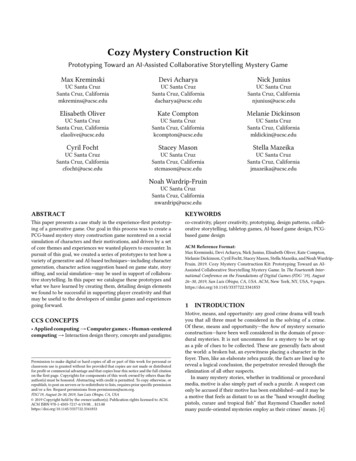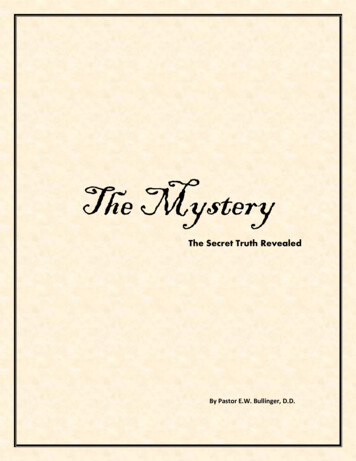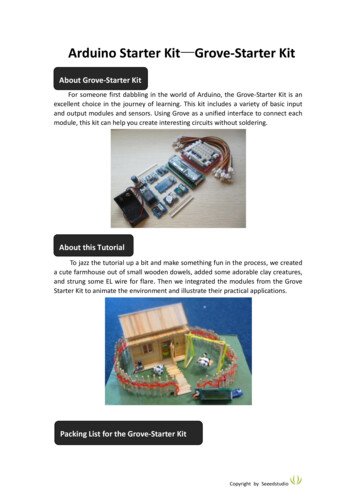
Transcription
Cozy Mystery Construction KitPrototyping Toward an AI-Assisted Collaborative Storytelling Mystery GameMax KreminskiDevi AcharyaNick JuniusUC Santa CruzSanta Cruz, Californiamkremins@ucsc.eduUC Santa CruzSanta Cruz, Californiadacharya@ucsc.eduUC Santa CruzSanta Cruz, Californianjunius@ucsc.eduElisabeth OliverUC Santa CruzSanta Cruz, Californiaelaolive@ucsc.eduKate ComptonUC Santa CruzSanta Cruz, Californiakcompton@ucsc.eduMelanie DickinsonCyril FochtStacey MasonStella MazeikaUC Santa CruzSanta Cruz, Californiacfocht@ucsc.eduUC Santa CruzSanta Cruz, Californiastcmason@ucsc.eduUC Santa CruzSanta Cruz, Californiamldickin@ucsc.eduUC Santa CruzSanta Cruz, Californiajmazeika@ucsc.eduNoah Wardrip-FruinUC Santa CruzSanta Cruz, Californianwardrip@ucsc.eduABSTRACTKEYWORDSThis paper presents a case study in the experience-first prototyping of a generative game. Our goal in this process was to create aPCG-based mystery story construction game ncentered on a socialsimulation of characters and their motivations, and driven by a setof core themes and experiences we wanted players to encounter. Inpursuit of this goal, we created a series of prototypes to test how avariety of generative and AI-based techniques—including charactergeneration, character action suggestion based on game state, storysifting, and social simulation—may be used in support of collaborative storytelling. In this paper we catalogue these prototypes andwhat we have learned by creating them, detailing design elementswe found to be successful in supporting player creativity and thatmay be useful to the developers of similar games and experiencesgoing forward.co-creativity, player creativity, prototyping, design patterns, collaborative storytelling, tabletop games, AI-based game design, PCGbased game designCCS CONCEPTS Applied computing Computer games; Human-centeredcomputing Interaction design theory, concepts and paradigms;Permission to make digital or hard copies of all or part of this work for personal orclassroom use is granted without fee provided that copies are not made or distributedfor profit or commercial advantage and that copies bear this notice and the full citationon the first page. Copyrights for components of this work owned by others than theauthor(s) must be honored. Abstracting with credit is permitted. To copy otherwise, orrepublish, to post on servers or to redistribute to lists, requires prior specific permissionand/or a fee. Request permissions from permissions@acm.org.FDG’19, August 26-30, 2019, San Luis Obispo, CA, USA 2019 Copyright held by the owner/author(s). Publication rights licensed to ACM.ACM ISBN 978-1-4503-7217-6/19/08. . . 15.00https://doi.org/10.1145/3337722.3341853ACM Reference Format:Max Kreminski, Devi Acharya, Nick Junius, Elisabeth Oliver, Kate Compton,Melanie Dickinson, Cyril Focht, Stacey Mason, Stella Mazeika, and Noah WardripFruin. 2019. Cozy Mystery Construction Kit: Prototyping Toward an AIAssisted Collaborative Storytelling Mystery Game. In The Fourteenth International Conference on the Foundations of Digital Games (FDG ’19), August26–30, 2019, San Luis Obispo, CA, USA. ACM, New York, NY, USA, 9 ODUCTIONMotive, means, and opportunity: any good crime drama will teachyou that all three must be considered in the solving of a crime.Of these, means and opportunity—the how of mystery scenarioconstruction—have been well considered in the domain of procedural mysteries. It is not uncommon for a mystery to be set upas a pile of clues to be collected. These are generally facts aboutthe world: a broken bat, an eyewitness placing a character in thefoyer. Then, like an elaborate zebra puzzle, the facts are lined up toreveal a logical conclusion, the perpetrator revealed through theelimination of all other suspects.In many mystery stories, whether in traditional or proceduralmedia, motive is also simply part of such a puzzle. A suspect canonly be accused if their motive has been established—and it may bea motive that feels as distant to us as the “hand wrought duelingpistols, curare and tropical fish” that Raymond Chandler notedmany puzzle-oriented mysteries employ as their crimes’ means. [4]
FDG’19, August 26-30, 2019, San Luis Obispo, CA, USAThis “puzzle mystery” tradition, perhaps best exemplified by theworks of Ellery Queen, is a rich one. And the logical structure ofits plots makes this tradition an attractive target for proceduralgeneration. And yet we believe that procedural mystery generationwill be impoverished if this tradition is the only one represented.So our work has focused on generative support for mystery gameexperiences in a different tradition. This tradition is perhaps bestexemplified by Chandler—but not because of the “hard boiled” settings or main characters often associated with him. Rather, becauseof his focus on character relationship and emotion as the centerof his stories—with motive only understandable in this context—sometimes sacrificing the logical structure of the mystery plot inthe process.This is different from the puzzle focus in the Queen tradition,and also different from the action-oriented tradition found in the“pulp” publications in which Chandler began his career. ThoughChandler argued it was central even there: “My theory was thatreaders just thought that they cared about nothing but the action;that really, although they didn’t know it, they cared very little aboutthe action. The thing they really cared about, and that I care about,was the creation of emotion through dialogue and description.” [5]In this paper, rather than presenting technical progress towarda recognized goal in procedural content generation, we attemptto present a design exploration of new possibilities for the use ofgenerative methods in games, guided by an understanding of genreand a set of design goals for the experience we want to create. Wefirst introduce the design pillars and intended play experience thatinformed our design decisions and guided our prototyping. Webriefly survey related work in mystery scenario generation, collaborative story construction play experiences, and the use of socialsimulation in narrative games. We then describe a series of prototypes we developed over the course of approximately six months ofwork, gradually iterating toward an enjoyable play experience thatadheres to our design pillars while using AI and generative methodsto provide players with creativity support. Next, we discuss severalfeatures we found to be especially supportive of player creativityduring the prototyping process. Finally, we briefly discuss broaderlearnings from the prototyping process as a whole and possiblenext steps for this work.2 DESIGN GOALS2.1 Story and Aesthetic DesignOur project seeks to support a mystery genre experience aboutcharacter relation, emotion, and motive. For us, the heart of motiveis character interactions, the social buildup preceding a crime andthe social fallout after it has occurred. We focus our investigationnot on the where or the how (as one playing Clue might), but ratheron the why. What drives a character, particularly in a world inwhich there are no monsters, to commit crime, potentially as severeas murder?We investigate how to best expose this dimension of mysteryto players, making use of AI and PCG in conjunction with humanreasoning and feeling. Our current design direction is toward experiences in which two human players with differing responsibilitieswork cooperatively with an AI system to construct mysteries inM. Kreminski, D. Acharya, N. Junius, E. Oliver et al.which the social and emotional motivations are the driving forceof the story’s construction.We want the emotional tone of these stories to work within the“cozy” mystery tradition. In our research on exemplars, we havefound that this tradition actually has four key features, which maybe more or less present in any given work. In our design discussions we refer to these as the four axes of coziness: Sociological(everyone is good, there are no monsters), Structural (plot wraps upnicely), Nonviolent (no or little violence), and Thematic (the storyrevolves around things like knitting, dog shows, or rose breeding).Our prototypes thus far have held close to the cozy end of the sociological axis (it is the key driver of our emotional tone), with theeventual goal of supporting players who wish to have an experienceclose to the cozy end of the structural axis, varying wildly on thephysical/violence axis, and with a thematic setting (a snowed-inobservatory, full of researchers) that is probably cozy for us (andmany readers of this paper) but not for the average mystery fan.2.2Play Experience DesignThe eventual play experience we envision, shaped by the processof prototyping we document in this paper, involves two playersboth taking on the role of a storyteller. One of the players, theAgatha player (named in honor of mystery author Agatha Christie),is primarily in charge of making decisions about higher level plotconcerns, similar to the beat construction in Façade. The otherplayer, the detective player, is focused more on the individual characters’ goals and actions, similar to the actions in Prom Week or thesocial moves in Versu. The computational system supporting theplayers is primarily responsible for keeping track of what has happened and what has been deemed "true" by the players up to thatpoint. This system also needs to help mediate possible characteractions and plot developments to provide a degree of constraintsand suggestions to help the players continuously work towards thecreation of a complete story.Several aspects of this design—most notably the distinct andasymmetrical roles of the two human players and the placement ofthe computer in a supporting role to this collaboration—were inspired heavily by Bad News [27]. However, we realized early on thatto extend a Bad News-like experience to a broader audience wouldrequire extensive creativity support. Bad News’s success hinged notonly on the underlying town simulation but also on the capabilitiesof two human participants other than the "player." First of thesewas the actor, who would have to repeatedly take up the role of adifferent simulated character and improvise convincingly as thatcharacter at a moment’s notice. And second was the wizard, whowould sit behind the scenes during a playthrough of Bad News andpore over the simulation state in real time, seeking out narrativelyinteresting information to feed the actor—sometimes even directlyin response to a player’s question, with the actor unable to answerthe question until the wizard fed them the necessary information.Both the actor and the wizard thus needed deeply specialized skillsto make the experience operate successfully, and the majority ofordinary players could not be expected to function in similar roleswithout a great deal more support from the system.
Cozy Mystery Construction KitMoreover, even if the system was successful at scaffolding playercreativity, we suspected that there was no way to make the experience work with general audiences other than to relax the expectations the experience as a whole would place on its participants. As aresult, we found ourselves drawing further design inspiration from“GM-less” tabletop story construction games like Microscope [23]and The Quiet Year [1]. Ultimately, we decided, what we reallywanted was something less like a conventional mystery story generator and more like a casual creator [7] for a certain specific kindof mystery story.3 RELATED WORK3.1 Mystery GenerationA number of other projects have undertaken the task of procedurallygenerating mystery stories or scenarios, some specifically in serviceof player experience in the context of games. The generation ofstatic mystery stories dates back at least as far as 1971, with Klein’swork in narrative generation [15, 16] serving as an early example.More recently, a wide variety of approaches to the proceduralgeneration of mystery stories or scenarios for players to experienceor explore interactively have been proposed. Stockdale [31] has generated playable murder mystery scenarios by generating networksof characters, selecting a single motive/perpetrator/victim combination at random, and then generating character interaction histories“in reverse” to ensure that the murder seems plausible. Barros etal. [2] have made use of open data to generate murder mysteryscenarios involving networks of associated historical figures. Mohret al. [21] have used Dynamic Epistemic Logic [8], “the logic ofchanging knowledge and beliefs”, to generate mystery scenarios forplayers to solve, with a focus on ensuring that all character actionsare plausibly motivated. Their work also enables a style of playerinteraction that includes the interrogation of characters who arecapable of lying in motivated ways (for instance, to cover up theirinvolvement in a crime.)Among commercial experiences, The Shrouded Isle [10] standsout for its extensive reliance on the player’s investigation and gradual revelation of the attributes of procedurally generated charactersas part of gameplay. Although the game does not advertise itself asincorporating a mystery scenario generator, the natural course ofplay hinges on the player’s understanding of emergent proceduralmysteries whose solutions will frequently have a direct impact onthe player’s choices about which characters to trust.Adjacent to the challenge of mystery generation is Horswill’sand Robison’s recent work on operationalizing the questionnairebased character creation process in Dread [12]. By tagging answersto a variety of character creation questions with their logical implications about a character who would give those answers, it ispossible to use a SAT solver to generate random characters whosebackstories are consistent with the answers the player provided.This same architecture could be employed to generate progressivelysmaller sets of valid solutions to a mystery scenario as the playeruncovers clues—or, in the context of mixed-initiative mystery storyconstruction, as the user adds constraints to the scenario. Some ofthe prototypes we report in this paper have made tentative stepstoward the use of answer set programming [29] to similar ends.FDG’19, August 26-30, 2019, San Luis Obispo, CA, USABroadly speaking, most of these projects have focused on thegeneration of logically consistent mystery stories or scenarios. Somehave added to this focus a further goal of ensuring that players orreaders are presented with a sufficient set of clues to enable themto solve the mystery with only the information made available tothem through the course of reading the story or playing the game.The interactive experiences discussed here universally place theplayer in the role of the detective, with player interaction essentiallyboiling down to the solving of an elaborate logic puzzle.We are interested in the mystery genre primarily for its thematicfocus on the search for truth. Moreover, we are more interested inempowering players to construct their own mystery stories thanin presenting them with generated mystery scenarios they mustsolve. As a result, we draw on existing mystery generation workonly lightly, and only insofar as it can be repurposed in support ofplayer creativity.3.2Social Simulation in Narrative GamesIn pursuit of interactivity and reactivity, narrative games have, tovarying degrees, incorporated social simulation to guide characterbehavior. Some of this variance is based on whether the games arefocused on the experiencing of the story, as is the case with Façadeand Blood and Laurels, or the discovery of the story, as is the casewith Prom Week and Bad News.Façade, being an interactive drama, is primarily concerned withmaintaining a coherent plot and experience through its beat structuring. It uses light elements of social simulation, the abstract socialgames, as part of organizing and choosing beats and tracking staterather than centering the entire experience on the playing of thesegames [18]. This lack of player focus on the social games is partially due to Façade maintaining a theatrical aesthetic and relyingprimarily on the characters’ expressiveness, rather than traditionalinterface elements, to convey the state of the social simulation.While Blood and Laurels, by virtue of being built with Versu, is aninteractive drama like Façade, it has a more decentralized method ofstructuring its plot. The individual agents in Blood and Laurels arethe ones primarily responsible for knowing their motivations andgoals and taking action rather than being constrained by beats inthe way Façade’s characters are [9]. Additionally, in Versu stories,characters and roles are defined separately, allowing for a combinatorial approach to casting characters in roles—similar to theexploration of generative characters we describe in Section 3.1.In contrast to our positioning of players as different aspects ofa storyteller, both Façade and Versu cast players in a specific rolefor each playthrough. This means that whatever creative power aplayer has in these stories is limited mostly to the creativity feltby an actor [17] rather than a storyteller and the acting out of theparticular version of the story is the goal of these experiences. Asa result of this focus, the social simulations found in these gamesare concerned with maintaining the integrity of the world and plotmore than allowing a collaborative construction of a story.Unlike our work discussed in this paper, the initial work towardComme il Faut (CiF), a social simulation system built around modeling character interaction through social games [19], began beforedevelopment on Prom Week, the key experience created with it [20].In this way Prom Week’s development was, at least partially, guided
FDG’19, August 26-30, 2019, San Luis Obispo, CA, USAby the constraints of CiF’s initial design. We have approached thedevelopment of a social simulation-focused game from the oppositedirection, first identifying an experience we want to give playersand then developing a social model to help implement those designgoals.Bad News [27] is a computational theater experience where aplayer must notify the next of kin of a deceased person. The bulkof the computational side of Bad News’s social simulation is runbefore the game begins and is updated on the fly through directhuman input. Additionally, all character interactions are mediatedthrough a live human actor. This live performance allows for asignificantly higher amount of flexibility in characterization andinteraction than any of the purely computational systems we havedescribed and is part of the reason we are interested in building alive, local multiplayer experience.While social simulation has been used successfully as part ofnarrative experiences, it has not been brought to bear in the worldof story construction to the same degree. One of our goals withthis project is to marry the liveness found in the play of Bad Newswith the liveness of the social simulation found in the likes ofProm Week to allow for a reactive and constrained environmentto build stories in. As Laurel describes in Computers as Theater[17], constraints on players (and actors) can encourage rather thandiscourage creativity and we view our usage of social simulationas providing these constraints to help encourage player creativity.3.3Story Construction Play ExperiencesIn his dissertation, Reed notes that “sculptural fiction,” a type ofinteractive narrative centered around the creation of a story graphrather than the traversal of one, is a reaction to the limitationsof graph based interactive story games [22]. This explicit moveaway from pre-built graphs was one of the major inspirations ofthe direction we decided to explore using the prototypes discussedin Section 3. Reed points to The Ice-Bound Concordance as a culmination of his work with sculptural fiction as it embodies the coreelements of sculptural fiction [22]: Low-cost and reversible decisions The expressive exploration of possible stories A system that highlights potentially interesting additions A high-level view of the entire storyOur goal of creating a mixed-initiative table-top-esque experience means that, unlike with The Ice-Bound Concordance, the computational system does not have to be the primary facilitator of allof these elements. It is, however, still responsible for highlightingwhat it thinks are relevant additions and helping make decisionsmalleable. By offloading part of the expressive exploration of stories to the two players, they in turn have a greater stake in theshared authorship 1 [26] with the computational system. This goalof shared authorship is also our reason for giving the two playersseparate parts of the whole story domain to take ownership overand having the computer mediate between those levels.In providing players with additional scaffolding to support thecreative process at the cost of full control over the kinds of storiesthey can tell, these story construction experiences can arguably be1 Samuel defines shared authorship in his dissertation as "the act of creating somethingwith someone else that could not have existed without the both of you."M. Kreminski, D. Acharya, N. Junius, E. Oliver et al.usefully viewed as casual creators [7] for the storytelling domain.This is the perspective that we take in our own work: we are attempting to build a casual creator that supports the collaborativeconstruction of a certain specific kind of mystery story, and thefeatures of our system are therefore explicitly intended to providesupport for player creativity.4PROTOTYPESOver the past six months, we have constructed a series of prototypesto develop our design. In keeping with Gingold and Hecker’s guidelines for prototyping [11], we crafted each prototype to answera specific question or questions about the design space in whichwe are working. Prototyping work alternated between our lab’sweekly group meeting and a series of smaller, more task-focusedmeetings that were set up on a week-by-week basis. Meetings ranfrom 1-3 hours each, with the size of the group varying from 3-6for smaller meetings up to 10 for whole-group meetings.4.1Character GenerationFor character generation, we focused on creating prototypes modeling characters and their relationships to one another. One of theelements we wanted to explore in this space was what elements wewanted to be fundamental to each character, and how that coulddrive the kinds of interactions between characters and thus storieswe told with those characters. We also wanted to investigate howcreating characters would work in a generative system. Would ourmethod for generating characters and their relationships to oneanother consistently provide enough variety for each playthroughto seem novel, while still providing consistently compelling storiesfor players? And if not, how could we tweak the current way wegenerate characters or make them in new ways to mitigate theseproblems?4.1.1 Paper Prototypes. For our character generation paper prototypes, we began with modeling out what elements we wantedcharacters to have. These were elements that should make thecharacter unique, and help to create interesting stories betweencharacters in a generative storytelling process. We modeled severaldistinct traits for each character, including: Two values, representing what the character holds importantand defining what actions they would consider to be a crime.Values also served as a point of affinity or contention withother characters. We initially began prototyping with a setof eight values, chosen based on the themes we desired toemphasize within the game and their imagined potentialfor interesting storytelling: science, survival, communalism,funding, comfort, order, faith, and progress. Our hope is that,if we reify the themes we hope to address as mechanics,players will naturally find themselves constructing storiesthat turn on these themes. We are inspired here by a similarapproach taken in the design of The Shrouded Isle [10], whichthe designers refer to as an instance of subjective simulationdesign [13]. One primary and one secondary character trope, pulled froma manually filtered list of character tropes originally drawnfrom TVTropes.org. We include these primarily to supportthe players in imagining a personality for each character.
Cozy Mystery Construction KitFDG’19, August 26-30, 2019, San Luis Obispo, CA, USA Occupation, defining the character’s role in the observatory.This could help to inform the character’s motivations, andcould also be used to build out relationships between characters, as mentioned below.We also used paper prototyping to model characters’ relationships to one another. Because this generative storytelling gameis built on a social graph of relationships between characters, itwas important to provide these relationships, both to help players know more about each character, and to provide more contextfor that character’s motivations (for instance, why one of themmight or might not be the perpetrator of a crime). In our prototypeswe modeled several different elements of relationships betweencharacters: Formally recognized relationships, such as the professionalrelationship between a professor and a student or the romantic relationship between a married couple. These weretreated as semi-permanent and unlikely to change in thecourse of play. Valence of characters in their feelings of one another—whethera character liked, disliked, or felt neutral to another character. These could change through play, for instance if onecharacter performed an action that another disliked. Other character relationship modifiers—we looked at otherinteresting ways to connect characters to one another, suchas defining characters as rivals to one another, or denotingthat one character has a secret crush on another.Paper prototype evaluation happened over several different playsessions. They mainly involved writing down character traits andrelationships on cards, passing them out randomly, and then describing various reasons why each character might commit a crimeand how elements such as relationships and traits might influencecharacters’ affinities to one another. We used different combinationsof character traits and relationships, and ended up incorporatingthose that worked well together in our digital character generationprototype.4.1.2 Digital Prototypes. From our paper prototypes for charactergeneration, we were able to construct a digital prototype of a socialgraph generator. This generator worked as a quicker stand-in formethods we had previously used to generate characters and theirrelationships to one another, and that could then be used for otherprototypes, such as generating transcripts or crime graphs froma list of characters. Because the digital prototype used constraintsolving to build out the list of characters and relationships, it couldalso more easily ensure that the list of characters and their relationships made sense with one another, for instance ensuring thatevery student had a professor they worked for. These variables andconstraints could be easily tweaked and their outputs evaluated using the digital prototype, so that we could figure out combinationsthat make sense and lend themselves to diverse and interestingstories.Running the generator, we get a list of characters and relationships such as the following:has modifier("Bob","celebrity status").has modifier("Georgia","has funding").has modifier("Henry","secret expert").Figure 1: A visualization of a generated cast of characters.Colored arrows between characters indicate which valuesthey share; shared values draw characters closer together.has profession("Alice","professor").has profession("Bob","student").has profession("Georgia","student").has profession("Henry","professor").has relationship("Alice","Henry","mentor of").has relationship("Bob","Henry","working for").has relationship("Georgia","Henry","working for").has relationship("Henry","Bob","rivals").has relationship("Henry","Bob","professor of").has relationship("Henry","Georgia","professor of").has value("Alice",1,"Order").has value("Alice",2,"Funding").has value("Bob",1,"Science").has value("Bob",2,"Funding").has value("Georgia",1,"Faith").has value("Georgia",2,"Comfort").has value("Henry",1,"Order").has ary","Parent lity("Bob","secondary","Socially .personality("Henry","secondary","Optimist").
FDG’19, August 26-30, 2019, San Luis Obispo, CA, USAThis list of characters and relationships could then be evaluatedby creating transcripts of stories based on the list of characters.4.2TranscriptsOur intention in creating transcripts was to model the play experience, particularly the interactions between players and thecomputational system. By playing out different interaction patternsbetween the detective player, the Agatha player, and the system,we could test out the interactions we believed would support thekinds of experiences we wanted players to have, and discover whatkinds of actions we wanted players to be able to take that werenot already afforded to players. We could also use transcripts toexamine the kinds of stories that we could generate through thisinteraction, evaluating story length, plot arcs, and the dynamicsbetween characters in each of the stories. In the construction ofthese transcripts, we had a human step in to play the role of the AIsystem; this enabled us to assess the kinds of prompts we wantedthe system to generate, clarify what the system would need to knowin order to generate those prompts, and evaluate different styles of
generative methods in games, guided by an understanding of genre and a set of design goals for the experience we want to create. We first introduce the design pillars and intended play experience that informed our design decisions and guided our prototyping. We briefly survey related work










